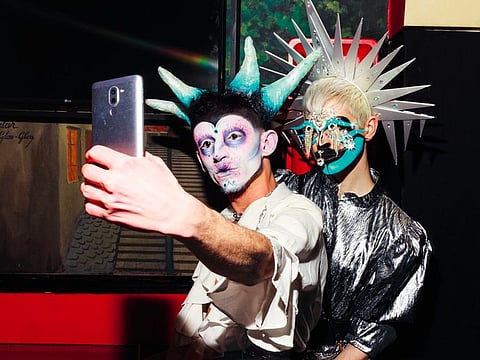Delving into Paris' underground party scene
How The Club Kids are reviving Parisian nightlife in a post-genre world

Highlight
Paris nightlife is back in a whole new way. The Club Kids are creating a post-genre world. Over the course of one night, we followed them on their exploits.
“Let me introduce you to my friend Peter!” exclaims Klaus wieKind, pointing to one of his friends before heading to a party at House of Moda. We like to use nicknames.” With his wildlife-inspired outfit, he bursts onto a subway train while his friend Karma performs a dance in front of bewildered passengers. “We always take the subways to parties, it’s a political act.” Klaus, an art student by day and performer by night, explains, “With Thibaud @tyggythorn and Hugo @lemarmoset, the founders of the Kindergarten parties, we wanted to launch a movement to revive the Club Kids scene of the '80s and '90s.” On his Instagram account, we see him covered in a braided wire mask shaped into an animal’s head, or wearing trompe-l’œil makeup. For the past year and a half, the visual artist has been at House of Moda, Tech Noire and Flash Cocotte, seeking to push the boundaries of visual and physical performance art ever further. He continues, “I don’t have an official persona. Every time I go out, I can create something new. The Club Kid is a creature that transcends genre.”
Star like Warhol
It was in New York during the 80s and 90s that this underground scene became popular. The Club Kids are, first and foremost, Michael Alig and his sidekick James St James. They organised parties where the fashion and art scenes could mix with New York’s underground. In a conversation with Interview magazine in 1987, Alig said, “We were all going to become stars like Warhol and move to the Factory.” But the adventure ended differently. Alig was sentenced to 20 years in prison for murdering and dismembering one of his friends. The party promoters nevertheless made the club a place where minorities could meet. The parties quickly became famous and spread across the Atlantic. In England there were the Blitz Kids, the neoromantics who partied at London’s Blitz Club before heading to Paris and carving out a path across Europe. The group became home to a new generation of designers and muses like John Galliano, Alexander McQueen, Leigh Bowery and Jean-Paul Gaultier.
Fluo kids
“When I started partying in Paris around 2007, we understood that to attract the right groups, we had to be stylish. So we spent our time getting dressed up so people would notice us. One day, we did a photoshoot at La Java for the Fluo Kids blog and it took off from there,” says Naïla Guiguet. Better known as DJ Parfait, the young woman organises alongside Dactylo, the priestess of Parisian nightlife at Possession. It’s another party that’s reclaiming the heritage of the Club Kids. In two years, Possession has become a top destination with a sharp line-up of techno acts and welcoming atmosphere on the dance floor. “Today, techno is on the radio, you can hear it on your phone. But it’s not meant for listening in your room. Techno is a music of mixing, of sharing. You have to remember your roots,”insists Naïla Guiguet.
Partying is political
The idea is struggling to make its way in France, but clubbers around the world are convinced: partying is political. And in any case, the situation in Paris isn’t as rosy as some would like to believe. At the end of 2017, La Mutinerie, an iconic bar, was threatened with closure. Only the determination of these performers banding together was able to prevent the worst. For Klaus wieKind,“Paris likes killing parties. There are very few events and clubs for performers in Paris, hence the strong mobilisation for La Mutinerie. It’s one of the last remaining spaces, along with 3W Café and WET For Me.” But if partying is political, it’s also about having a good time. Fashion stylist and Club Kid performer, Timothé Grand-Chavin explains, “The important thing is to have fun. At these parties, you can be whoever, you can do whatever you like. It’s complete freedom !” Klaus wieKind remembers, “At the first Kindergarten, with BabyGross and Humber, we had to improvise a hula-hoop performance. We ended it by asking everyone to get on stage and participate in the show. I’m here to promote a discourse but also to entertain people. The stuff that makes these parties fun is also what makes them crazy, what creates friction.” These last few years, the Club Kids have gone international. Even though London remains a major scene, partially because of the support of designers like Charles Jeffrey, Amsterdam has taken the crown as the top spot for partygoers. “Because the city is a symbol of freedom in Europe, “Because the city is a symbol of freedom in Europe, the party scene there has really been able to flourish,” explains Alain Chaney, a curator and performer who’s been there for a year.
Living together
The new scene isn’t just organised around clubs, partially because of administrative constraints, meaning its communities have become much more porous. The parties follow each other without stepping in each other’s way booking on the same date or picking the same DJ or venue. The instructions are clear: There’s a place for everyone. “My outfits can be scary, but then people hear my tiny voice, they see how short I am, and I give everyone a hug. After a few minutes the fear passes and they see it was all just an illusion, they were reacting to not knowing what it was they saw.” You learn how to live together at a party. Spread the word.
Sign up for the Daily Briefing
Get the latest news and updates straight to your inbox



